Key takeaways:
- Mixed lighting conditions can enhance creativity but also pose challenges in capturing accurate colors and moods.
- Techniques such as adjusting camera settings, using reflectors, and experimenting with angles help manage mixed lighting situations effectively.
- Post-processing strategies, including adjusting white balance and applying color grading, are essential for harmonizing images captured under mixed lighting.
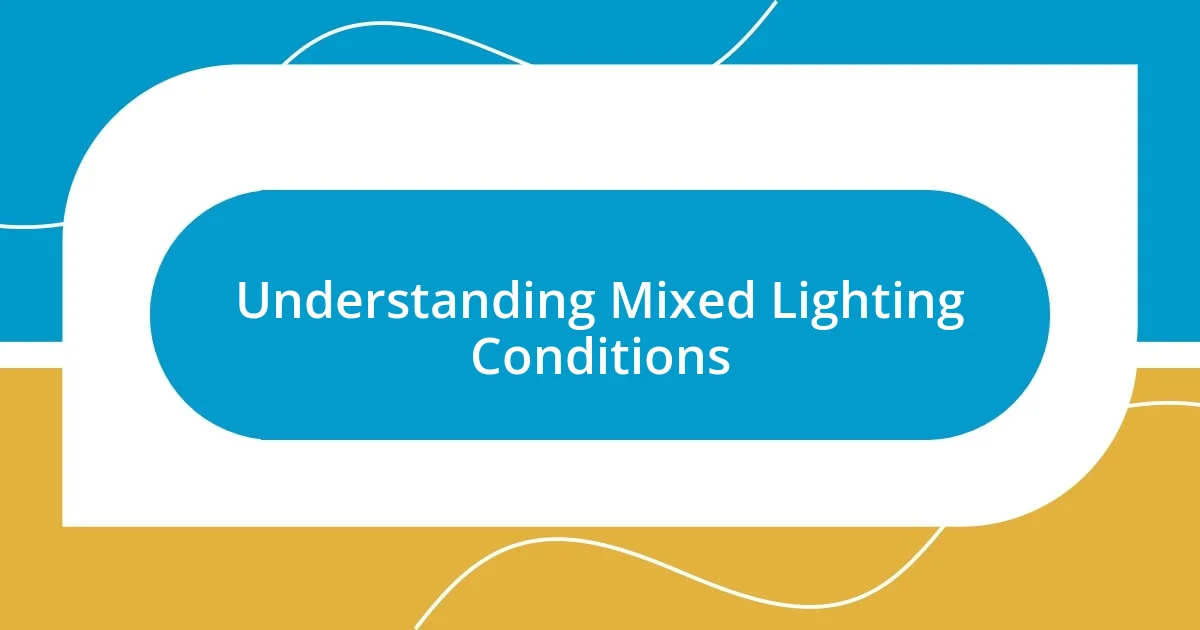
Understanding Mixed Lighting Conditions
Mixed lighting conditions can feel like a double-edged sword, can’t they? Picture yourself in a cozy café where the warm glow of lamps competes with the harsh daylight streaming through the windows. I’ve often found myself grappling with such contrasts, noticing how they can impact not just how things look, but how I feel in that space. Sometimes, I feel energized by the vibrant mix, while other times, it makes me restless, unsure of where to focus my attention.
When I delve into these lighting conditions, I remember a photography workshop I attended. The instructor explained how different light sources, like fluorescent lights and candle flames, affect colors and shadows in unpredictable ways. It clicked for me then—this is more than just aesthetics; it’s about mood and emotion. I’ve discovered that in my own practice, adjusting my camera settings to compensate for that mixture allows me to capture the moment’s essence better.
Have you ever tried to adjust your settings or even just your angle to minimize the chaotic contrasts? I find that being mindful of mixed lighting can lead to surprisingly intimate photographs. It’s in these times where I’ve learned to embrace imperfections, seeing them as opportunities for creativity rather than obstacles.
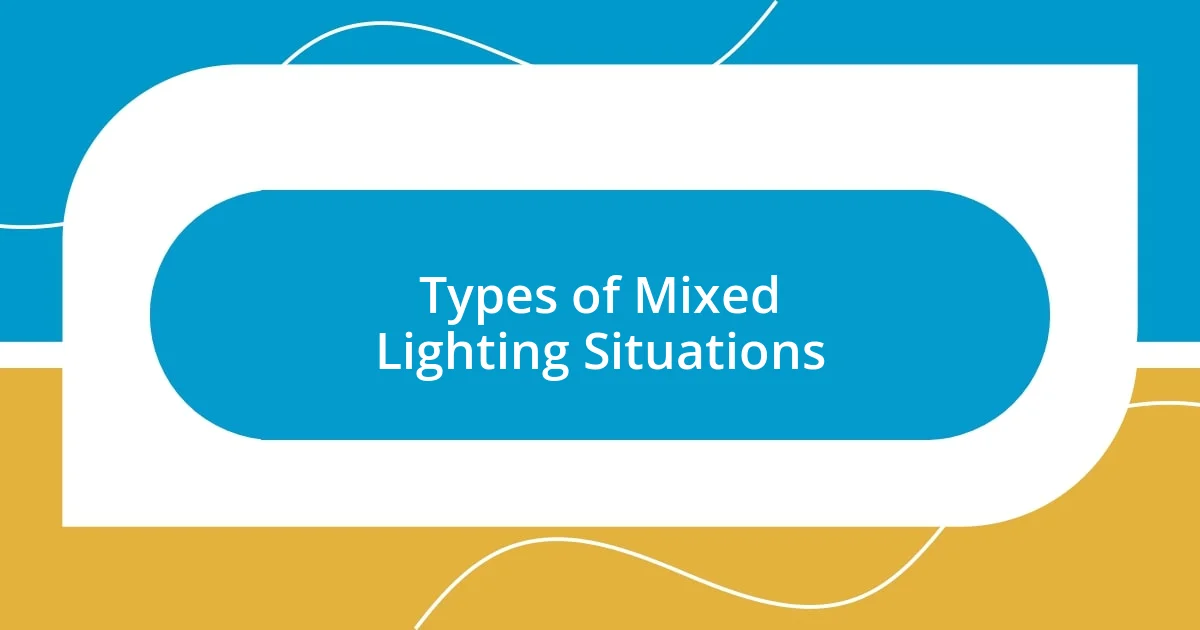
Types of Mixed Lighting Situations
Mixed lighting situations can emerge from various sources, creating unique atmospheres that are both challenging and fascinating. I remember once visiting a friend’s apartment during a sunset. The rich, warm hues of the sunset battled against the clinical white of overhead fluorescent lights. My camera struggled to balance the two, and I found myself torn between capturing the golden glow outside and the stark indoor lighting—this kind of conflict can be incredibly engaging, yet frustrating for a photographer.
Here’s a quick rundown of common mixed lighting situations you might encounter:
- Natural Light vs. Artificial Light: Daylight entering through windows contrasting with indoor lights, often seen in homes or cafés.
- Different Types of Artificial Light: Mixing warm tones from lamps with cooler tones from LEDs or fluorescents, creating dissonance and interest.
- Outdoor Light Variation: Situations such as shadows cast by trees that change as clouds roll in and out can create unpredictable lighting patterns.
- Multi-Source Environments: Spaces like galleries where spotlights collide with ambient light create dramatic visual effects.
- Candlelight with Electric Light: The soft flicker of candle flames alongside bright overhead lights adds a layer of warmth and intimacy, but can be tricky to photograph accurately.
Navigating these situations has taught me that adaptability is key. I often remind myself that the beauty lies in the tension between light sources, pushing me to explore and experiment more boldly. Each scenario offers an opportunity to tell a different story, shaped by those dynamic lighting conditions.
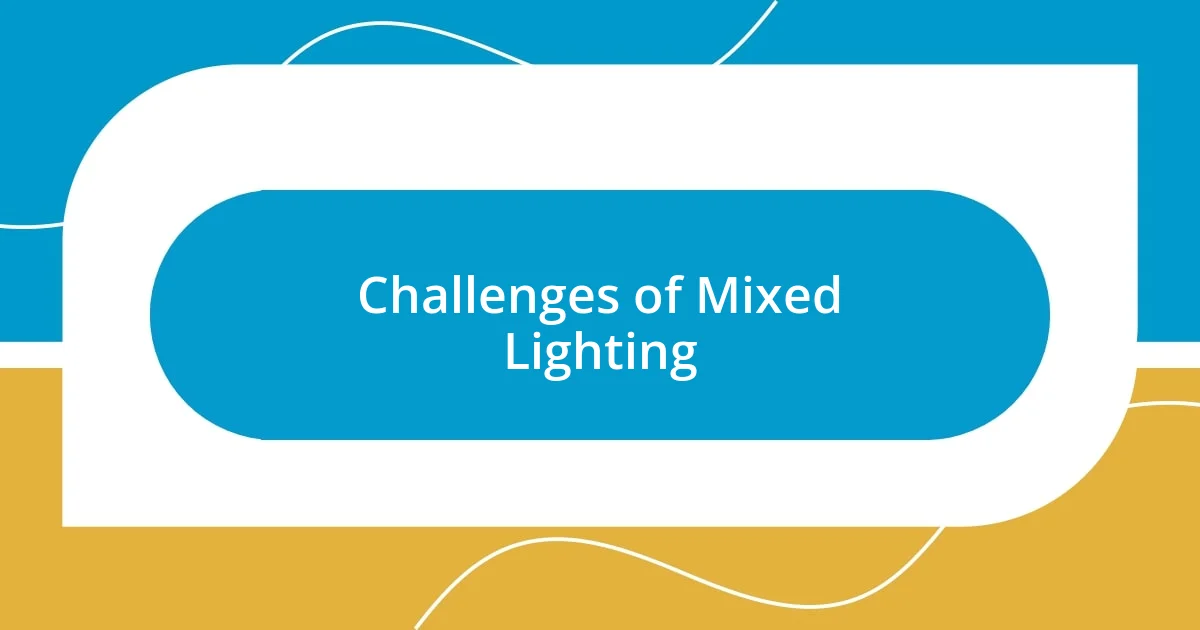
Challenges of Mixed Lighting
Mixed lighting can pose significant challenges, especially when it comes to accurately capturing colors and moods. I vividly recall a recent evening spent at an art gallery. The cool, artificial lighting mixed with warm spotlights cast intriguing shadows but made it difficult to see the true colors of the artwork. I felt a bit defeated as my camera struggled to find its balance, but I learned a lot about how vital lighting is in portraying emotions in art.
One of the most frustrating aspects I’ve encountered is the disparity in color temperature. When I was at a friend’s wedding, the venue’s harsh fluorescents clashed with the soft golden light from the candles on the tables. The inconsistent light left my photos looking either too cool or overly warm, making it hard to present the true ambiance of the celebration. It felt like I was battling the light, rather than working with it, which was a humbling experience that forced me to improve my skills in post-processing.
Another challenge relates to shadow and contrast. On a weekend trip, I photographed a beautiful landscape at sunset, but the dramatic contrasts between the orange sky and the shaded foreground made it hard to capture the scene as I saw it. I often reflect on moments like this, realizing that such challenges push me to adapt my techniques. Balancing mixed lighting is an ongoing journey, a dance of trial and error that eventually leads to more rewarding captures.
| Challenge | Personal Experience |
|---|---|
| Color Accuracy | At an art gallery, harsh lighting distorted colors in photos. |
| Color Temperature | At a wedding, fluorescent lights clashed with candlelight, affecting ambiance in photos. |
| Shadows and Contrast | An evening landscape shoot revealed hidden details obscured by extreme light contrasts. |

Techniques for Managing Mixed Lighting
When it comes to managing mixed lighting, I’ve found that using manual settings on my camera can be a true lifesaver. I remember a cozy dinner party where candlelight tangled with the harsh overhead lights. By adjusting the white balance manually, I managed to capture the warm glow of the candles while keeping the brightness of the artificial lights in check. It’s fascinating how a little adjustment can entirely transform the mood of a photograph.
Another technique I often rely on is employing reflectors. During a recent outdoor shoot, I faced a scenario where the sunlight was pouring in from one direction while shadows dominated the other. By placing a simple white reflector to bounce some light back, I was able to brighten the shadowed areas. It struck me how such a small tool can make a significant difference in achieving balance and harmony amidst clashing light sources.
I also believe that experimenting with angle and perspective can bring out the best in mixed lighting situations. At a local café, I decided to change my shooting angle to capture the golden afternoon light streaming through the window. It beautifully illuminated the table while keeping the artificial light softer in the background. Isn’t it intriguing how shifting a few degrees can alter the entire composition? Understanding the interplay between light sources can lead to some of the most compelling images in mixed lighting.
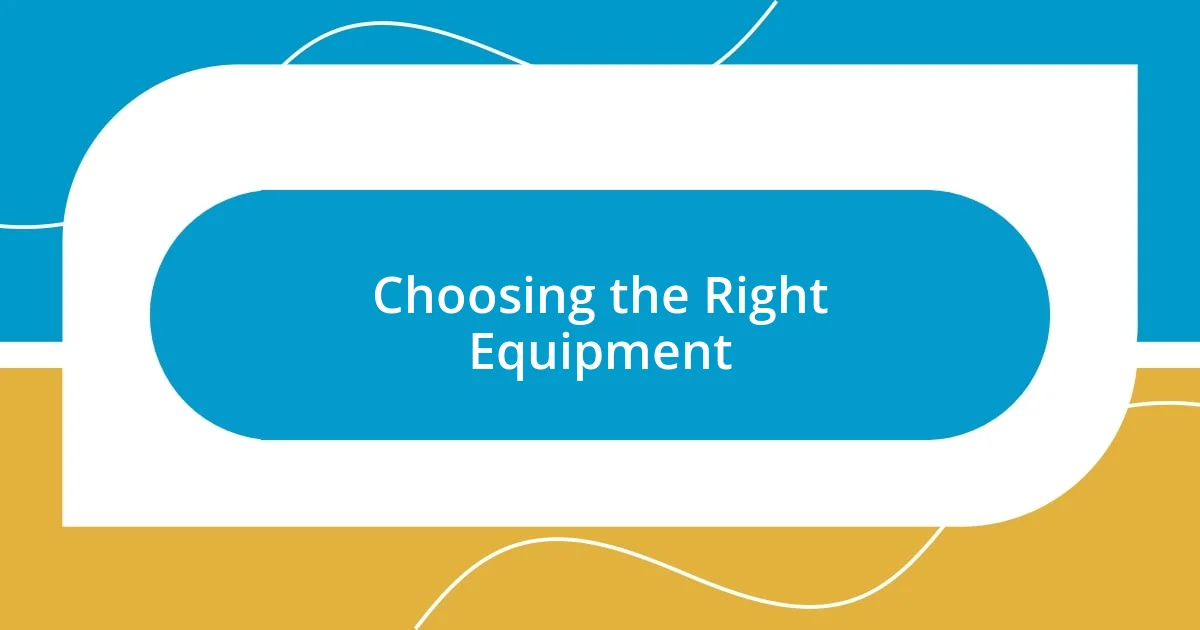
Choosing the Right Equipment
Choosing the right equipment can make a world of difference when dealing with mixed lighting. I still remember my first experience with a DSLR. It felt like I was handed a magic wand, but I soon realized that the lens choices were just as important. Investing in a lens with a wider aperture allowed me to capture more light, which helped balance those tricky indoor lighting scenarios, like when I attended a graphic design event under harsh fluorescent lights mixed with warm café light. Have you ever felt like your gear was holding you back? Trust me, I’ve been there.
For me, one of the game-changers was a camera with customizable settings. I discovered this during a twilight excursion on a city rooftop. The ambient sunset light was fighting with yellow streetlights, and I was scrambling to adjust the ISO and shutter speed. With a camera that allows for fine-tuning, I suddenly felt more in control, almost like I had a cheat code to conquer the chaos. Have you had a moment like that where the right tool opened up a new realm of possibilities? It’s empowering, isn’t it?
Tripods and stabilizers are another essential part of my kit, especially during low-light situations. I vividly recall a nighttime festival where the vibrant lights clashed with darkness, creating a stunning yet challenging display. My tripod became my best friend, allowing me to capture long exposures that beautifully showcased the lights without introducing motion blur. It’s moments like these that remind me of the importance of supporting tools in my photography journey. After all, having the right equipment not only enhances the outcome but also elevates my confidence in tackling any lighting situation.
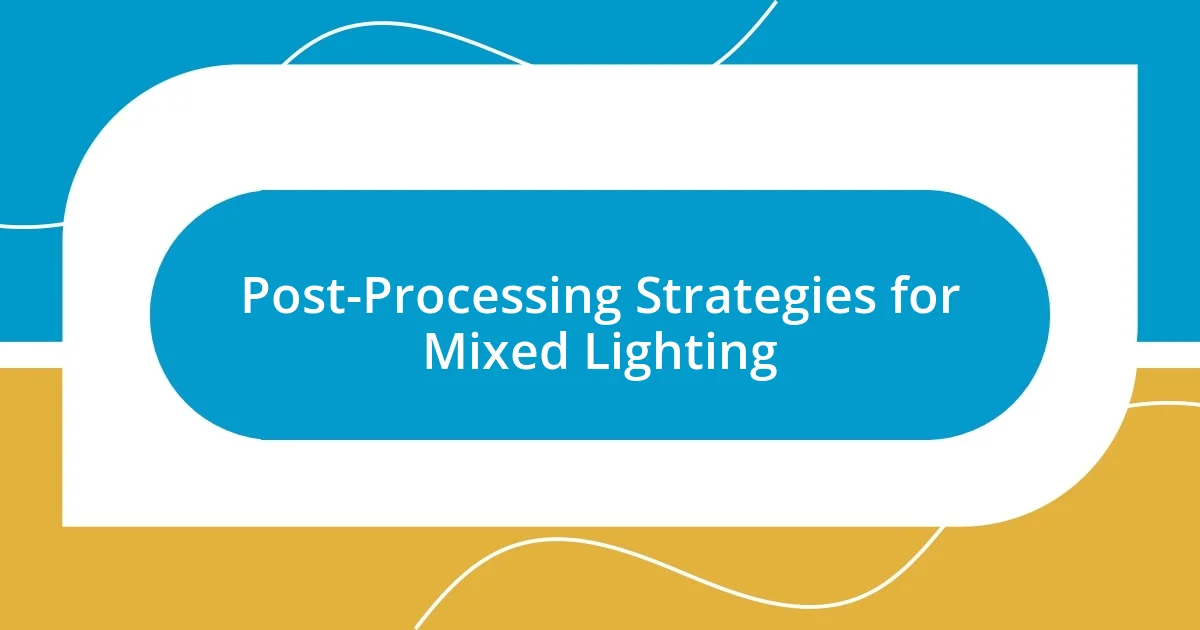
Post-Processing Strategies for Mixed Lighting
When it comes to post-processing mixed lighting, I always start by adjusting the white balance to achieve a unified look. I recall a visually captivating engagement shoot at dusk where the ambient light clashed with streetlights and twinkling fairy lights. By fine-tuning the white balance in my editing software, I brought the photo back to a cohesive warmth that let the romance of the scene truly shine. Have you ever felt like post-processing was just as important as the shooting itself? For me, it’s a critical phase where the magic happens.
Using software like Lightroom or Photoshop also allows me to selectively adjust exposure in different areas of the image. I often find myself faced with images where one side is bathed in golden sunlight while the other is drenched in shady hues. Recently, while editing a vibrant market scene, I was able to lift the shadows without blowing out the highlights. The power of targeted adjustments helps me breathe life into my images, transforming them from good to great. Isn’t it amazing how a few clicks can redefine a photograph?
I often apply color grading techniques to harmonize mixed lighting, enhancing the overall mood of the shot. During a moody winter evening event, the mix of fluorescent and candlelight left my images feeling disjointed. By applying a subtle teal and orange grade, I achieved a balance that evoked warmth and intimacy. It’s moments like this where I realize that color is not just a tool but an emotional language, speaking directly to the heart of the viewer. Have you tried using color grading to evoke feelings in your own work? If not, it might just be your next exploration in the creative process.

Real-Life Examples and Case Studies
Navigating mixed lighting conditions can be both a challenge and a delight. I recall a wedding I photographed where the reception hall had a stunning chandelier flanked by rows of warm candlelight. However, the harsh overhead lights created an unusual effect on skin tones. By using my knowledge of light temperature and adjusting my settings, I managed to capture the warmth of the ambiance while keeping the details sharp. Have you ever had a situation where lighting transformed a moment in front of you? It’s exhilarating when you finally get it right.
Another compelling case was during a street photography session at dusk. The fading natural light was intermingling with vibrant neon signs, creating a visually chaotic but beautiful atmosphere. With a keen eye, I decided to focus on silhouettes against the lights, which I found incredibly captivating. My instinct to embrace the chaos reminded me of how often we underestimate the artistic opportunities in mixed lighting. Have you explored street photography? It often leads to some unexpected but rewarding results.
I also remember a challenging outdoor portrait session amid changing weather. One moment we had direct sunlight, and the next, clouds rolled in, diffusing the light. This fluctuation prompted me to adjust my shooting techniques on the fly. By shifting locations and using the available light creatively, I was able to produce a series of striking images that captured the essence of spontaneity. Have you felt the thrill of adapting to unpredictable circumstances in your photography? It’s these moments that undoubtedly fuel our creativity and growth.














